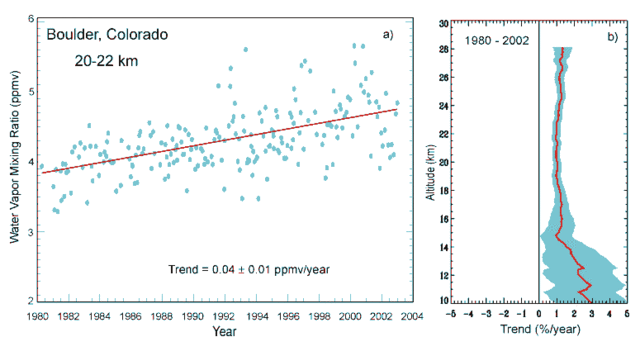 |
This is a file from the Wikimedia Commons. Information from its description page there is shown below.
Commons is a freely licensed media file repository. You can help.
|
 |
This graph image could be recreated using vector graphics as an SVG file. This has several advantages; see Commons:Media for cleanup for more information. If an SVG form of this image is already available, please upload it. After uploading an SVG, replace this template with {{ vector version available|new image name.svg}}. |
Summary
Stratospheric water vapor 1% increase. 30% may be due to increased methane.
- Observations using balloon-borne frost-point hygrometers, have detected an approximately 1% per year increase in stratospheric water vapor at Boulder, Colorado, since 1980. Besides implications for climate change, increased water vapor can affect the rate of chemical ozone loss, for example, by increasing the incidence of polar stratospheric clouds. Satellite measurements of water vapor, although not of adequate length for accurate trend determination, suggest that the increase may extend to other latitudes.
- Observations have provided evidence for a widespread increase in stratospheric water vapor, which plays a role both in cooling the lower stratosphere and in depleting ozone through chemical interactions, thereby contributing to climate processes. However, the water vapor trends are not fully defined, nor are their cause understood.
- Stratospheric water vapor measurements at a single location (Boulder, Colorado, U.S., 40°N) for the period 1981-2000 show a statistically significant increase of approximately 1%/year over altitudes 15-28 km. For the shorter period 1991-2001, global satellite measurements covering latitudes 60°N-60°S show a similar trend of 0.6-0.8%/year for altitudes ~25-50 km, but no significant trend at lower altitudes. The increases in water vapor are substantially larger than can be explained by tropospheric methane trends. Characterization of stratospheric water vapor trends is limited by the lack of global long-term measurements.
Licensing
| Public domainPublic domainfalsefalse |
 |
This image is in the public domain because it contains materials that originally came from the U.S. National Oceanic and Atmospheric Administration, taken or made as part of an employee's official duties.
|
|
Source: http://www.cmdl.noaa.gov/hotitems/watervapor.html
File usage
The following pages on Schools Wikipedia link to this image (list may be incomplete):
Wikipedia for Schools is one of SOS Children's Villages' many educational projects. SOS Children helps more than 2 million people across 133 countries around the world. There are many ways to help with SOS Children.





